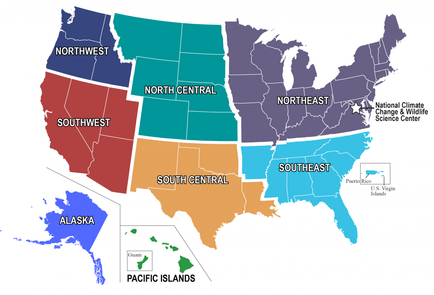Northeast Region
HISTORIES OF CHANGE
Given the history of settler colonialism in North America, concepts such as the "Northeast" do not reflect Indigenous perspectives on geography. For example, while the homeland of the Menominee is within an area that most consider either Midwest or northeast, the Menominee view their presence on the land as a living ancestral territory that spans present day non-indigenous descriptions of borders.
This differing perspective from the mainstream is also one shared by other Indigenous peoples at various distances, including many Potawatomi, Odawa, Ojibwe, and Dakota peoples who continue to inhabit areas west of the Great Lakes. On the other side of the Great Lakes, Haudenosaunee, Wabanaki, Wampanoag, Narragansett, Pequot, and Mohegan Tribes also continue to exercise self-determination on landscapes filled with similar stories of creation, colonialism and revitalization.
In many senses, Indigenous peoples in the U.S. context have long stories to tell about experiencing change. The Menominee, for example, practiced a complex seasonal round structure of governance that required the large ancestral territories that are still meaningful to Menominee peoples today. U.S. settler colonialism reduced the Menominee lands from 10 million acres to a present day 235,000 acre reservation.
Despite such large land dispossession and being forced to accept small reservations, Tribes such as the Menominee have developed innovative strategies for continuing to live within these ecosystems. The Menominee sustainable forest is an excellent example, if just one of many. Likewise, programs such as the Oneida Tribes and the Akwesasne Taskforce on the Environment - among other successes too numerous to name.
WORKING WITHIN CHANGE

Indigenous peoples collaboration with U.S. climate science organizations involves connecting Indigenous understandings of place with how climate scientists approach place.
The various illustrations on this website provide a small glimpse into the ancestral lands of Indigenous peoples as well as some of the impacts that Tribes have dealt with through the years in response to U.S. settlement.
Today the Department of Interior CASC defined Northeast region covers the ancestral lands of many Indigenous peoples - over 80 federally and non-federally recognized Tribes neighboring 22 states ranging from Minnesota in the West, Maine in the East and Kentucky in the South.
This region includes a diverse array of ecosystems including the Atlantic Coast, temperate and boreal forests, the St. Lawrence River, tallgrass prairies, the Appalachian Mountains, oak openings and the Great Lakes.
The Northeast Climate Adaptation Science Center, hosted by the University of Massachusetts, Amherst, is one of eight United States Department of Interior Climate Adaptation Science Centers in the United States.